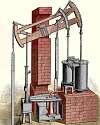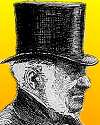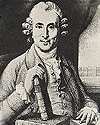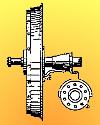
On 13 July 1781, a British patent was taken out by an English mining engineer, Jonathan Carter Hornblower, for the first compound steam engine. Boulton and Watt, who jealously guarded their patent rights as the commercial developers of steam engines, were not impressed.
Hornblower's family had shown inventive genius for two generations, and their interesting family history is described in this article from Dictionary of National Biographies (1901). At the end of the web page are links to further information on Hornblower's steam engine design.

On 13 Jul 1887, the second Tay Rail Bridge was opened in Scotland (and remains in use today). It was built to replace the original single-track railway which suffered a disastrous collapse during a gale in 1879. The passenger train crossing at the time plunged with everyone abroad to their deaths. It had been, for just 19 months, the longest bridge in the world. It is now known, to date, as the worst structural engineering failure in British history. Today's book pick is: Beautiful Railway Bridge of the Silvery Tay: reinvestgating the Tay Bridge disaster of 1879, by Peter R Lewis, a university engineering professor and acknowledged expert on the Tay Bridge Disaster. He gives the bridge’s history, evaluates the tragedy, and details how the Tay Bridge started to suffer irreparable damage of its joints (poorly designed and built) from the day that it carried trains, and that metal fatigue, rather than the gale, played a key role in its deterioration.
It is available from Amazon, typically about New from $19.23. Used from $5.39. (As of earlier time of writing - subject to change.)
 | The hand is where the mind meets the world. |
 | We really try to have only one new particle per paper. |
 | All of us are interested in our roots. Generally this interest is latent in youth, and grows with age. Until I reached fifty I thought that history of science was a refuge for old scientists whose creative juices had dried up. Now of course I know that I was wrong! As we grow older, we become more interested in the past, in family history, local history, etc. Astronomy is, or was when I started in it, almost a family. |
| Before you look at today's web page, see if you can answer some of these questions about the events that happened on this day. Some of the names are very familiar. Others will likely stump you. Tickle your curiosity with these questions, then check your answers on today's web page. | |
| Births | |
 | A mathematician and educator, born on 13 Jul 1944, invented a toy that became popular in the 1980s. The toy consists of 26 small cubes that rotate on a central axis; nine coloured cube faces, in three rows of three each, form each side of the cube. When the cube arrangement is randomized, the player must then return it to the original condition of faces with matching colors, which is one among 43 quintillion possible configurations. Can you name this man - and name his national origin? |
 | William Hedley, born 13 Jul 1779, was an English coal-mine official and inventor who was probably the first to build a commercially useful steam locomotive with driving wheels using the natural friction between their rims and the rails. The locomotive he put in service in 1813 to haul 50-ton coal wagons on a five-mile line was not retired until 1862. What was the name of this famous locomotive? |
| Deaths | |
 | Gabriel Lippmann (1845-1921) was a French physicist, who received the Nobel Prize for Physics in 1908 for an advance in photography. Lippmann was a giant of his day in classical physics research, especially in optics and electricity. He worked in Berlin with the famed Hermann von Helmholtz before settling in Paris to head (in 1886) the Sorbonne’s Laboratories of Physical Research until his death. His inventions include an instrument for precisely measuring minute differences in electrical power. What was the invention for which he was awarded a Nobel Prize? |
 | James Lind (1716-1794) was a Scottish physician, “founder of naval hygiene in England,” whose recommendation on the diet of seamen resulted in the prompt eradication of scurvy from the British Navy. (The Dutch had implemented this practice almost two centuries earlier.) Lind also recommended shipboard delousing procedures and suggested the use of hospital ships for sick sailors in tropical ports. In 1761, he arranged for the shipboard distillation of seawater for drinking water. What was the life-saving change in diet he recommended? |
| Events | |
 | On 13 Jul 1836, John Ruggles of Thomaston, Maine received a patent from the U.S. Patent Office, for a traction wheel used in locomotive steam engines. Before this one, there had been 9,957 patents issued. Ruggles was Chairman of the Committee on Patents of the U.S. Senate, and was instrumental in patent law reform. However, in 1838, a Senate select committee investigated corruption charges against Senator Ruggles relating to a patent application. What was the U.S. Patent Number of Ruggles' patent? |
 | On 13 Jul of a certain year, a power failure blacked out New York. Starting at about 9 pm, four lightning strikes on high-voltage transmission lines within a half-hour knocked out electricity and plunged millions of residents of New York City into darkness. Because of social tensions of the times, mobs set fires, smashed windows and hauled away food, clothing and appliances. It took 25 hours to restore power entirely. There were about 4,500 people arrested, and damage estimated at $61 million. In which decade did this happen? |
Fast answers for the previous newsletter for July 12: Buckminster • George Eastman • outboard motor • Panama Canal • foghorn.
 If you enjoy this newsletter, the website, or wish to offer encouragement or ideas, please send feedback by using your mail reader Reply button.
If you enjoy this newsletter, the website, or wish to offer encouragement or ideas, please send feedback by using your mail reader Reply button. Your click on a Facebook, StumbleUpon, or other social button on the site webpages is also a welcome sign of appreciation. Thank you for using them.
© This newsletter is copyright 2020 by todayinsci.com. Please respect the Webmaster's wishes and do not put copies online of the Newsletter — or any Today in Science History webpage. (If you already have done so, please remove them. Thank you.) Offline use in education is encouraged such as a printout on a bulletin board, or projected for classroom viewing. Online, descriptive links to our pages are welcomed, as these will provide a reader with the most recent revisions, additions and/or corrections of a webpage. For any other copyright questions, please contact the Webmaster by using your mail reader Reply button.
--
If you do not want to receive any more newsletters, Unsubscribe
To update your preferences and to unsubscribe visit this link
Executive Real Estate Business Class
Blog Archive
-
▼
2021
(585)
-
▼
July
(50)
- Newsletter for Saturday 31 July.
- Newsletter for Friday 30 July.
- Power off and play this summer!
- Newsletter for Thursday 29 July.
- Newsletter for Wednesday 28 July.
- Newsletter for Tuesday 27 July.
- Newsletter for Monday 26 July.
- Newsletter for Sunday 25 July.
- Newsletter for Saturday 24 July.
- Newsletter for Friday 23 July.
- Newsletter for Thursday 22 July.
- Newsletter for Wednesday 21 July.
- Newsletter for Tuesday 20 July.
- Newsletter for Monday 19 July.
- The Machines That Built America Premieres Tonight
- Newsletter for Sunday 18 July.
- Newsletter for Saturday 17 July.
- Newsletter for Friday 16 July.
- Newsletter for Thursday 15 July.
- Newsletter for Wednesday 14 July.
- Newsletter for Tuesday 13 July.
- On This Day for July 12 - Geraldine Ferraro design...
- Newsletter for Monday 12 July.
- Inventing ‘The Machines That Built America’
- On This Day for July 11 - Duel between Aaron Burr ...
- Newsletter for Sunday 11 July.
- On This Day for July 10 - Telstar 1 launched, John...
- Newsletter for Saturday 10 July.
- On This Day for July 9 - Catherine the Great assum...
- Newsletter for Friday 9 July.
- New Season! Hope, Through History Podcast
- On This Day for July 8 - Vasco da Gama's first voy...
- Newsletter for Thursday 8 July.
- Ending soon: savings that pop! 🎆
- On This Day for July 7 - Hawaiian Islands annexed ...
- Newsletter for Wednesday 7 July.
- On This Day for July 6 - Anne Frank forced into hi...
- Newsletter for Tuesday 6 July.
- On This Day for July 5 - Israel's Law of Return pa...
- Newsletter for Monday 5 July.
- On This Day for July 4 - Declaration of Independen...
- Newsletter for Sunday 4 July.
- July 4th Sale at the HISTORY Store!
- On This Day for July 3 - Battle of Gettysburg ende...
- Newsletter for Saturday 3 July.
- On This Day for July 2 - Civil Rights Act signed, ...
- Newsletter for Friday 2 July.
- July 4th savings that pop!
- On This Day for July 1 - Dominion of Canada establ...
- Newsletter for Thursday 1 July.
-
▼
July
(50)
-
Blogroll
-
About
HistoryFact










0 comments:
Post a Comment